|
|
 |
Fiche d'espèce de Copépode |
|
|
Calanoida ( Ordre ) |
|
|
|
Arietelloidea ( Superfamille ) |
|
|
|
Heterorhabdidae ( Famille ) |
|
|
|
Paraheterorhabdus ( Genre ) |
|
|
|
Paraheterorhabdus ( Sous-Genre ) |
|
|
| |
Paraheterorhabdus (Paraheterorhabdus) robustus (Farran, 1908) (F,M) | |
| | | | | | | Syn.: | Heterorhabdus vipera : Farran, 1905 (p.45);
no Heterorhabdus robustoides Brodsky, 1950 (1967) (p.346, figs.F,M); Minoda, 1971 (p.38); 1972 (p.326); Morioka, 1972 a (p.314); ? Hattori, 1991 (tab.1, Appendix); ? Park, W & al., 2004 (p.464, tab.1); ? Sedova & Grigoriev, 2005 (p.112);
no Heterorhabdus robustus : Farran, 1929 (p.266);
Heterorhabdus robustus Farran, 1908 b (p.65, figs.F,M, Rem.); Lysholm & Nordgaard, 1921 (p.26); Sars, 1925 (p.224, figs.F,M); Farran, 1926 (p.283); Rose, 1933 a (p.201, figs.F,M); Jespersen, 1934 (p.105); 1940 (p.54); Lysholm & al., 1945 (p.35); Farran, 1948 e (n°16, p.3, figs.F,M); Vervoort, 1951 (p.129, Rem.); Tanaka, 1960 (p.53: Rem.Grice, 1963 a (p.496); ? Tanaka, 1964 a (p.18, figs.F,M); Heptner, 1971 (p.157, figs.F, M); Harding, 1974 (p.141, tab. 2, gut contents); Kos, 19876 (Vol. II, figs. F,M, Rem.); Deevey & Brooks, 1977 (p.256, tab.2, Station "S"); Brenning, 1986 (p.13, Rem.); Nishida & Ohtsuka, 1996 (p.620); Bradford-Grieve & al., 1999 (p.883, 944, figs.F,M); Holmes, 2001 (p.16); Boxshall & Halsey, 2004 (p.125: figs.F,M); Vives & Shmeleva, 2007 (p.305, figs.F,M, Rem.); Cabal & al., 2008 (289, Table 1);
Ref. compl.: Sewell, 1948 (p.503, 514); C.B. Wilson, 1950 (p.240); Furuhashi, 1966 a (p.295, vertical distribution in Oyashio region, Table 6, 8); Grice & Hulsemann, 1967 (p.18); Morris, 1970 (p.2301); Park, 1970 (p.477); Roe, 1972 (p.277, tabl.1, tabl.2); Bainbridge, 1972 (p.61, Appendix Table III: occurrence); Björnberg, 1973 (p.345, 387); Vives & al., 1975 (p.50, tab.II, XII); Deevey & Brooks, 1977 (p.256, tab.2, Station "S"); Vives, 1982 (p.293); Roe, 1984 (p.358); Brenning, 1985 a (p.28, Table 2); Homma & al., 2011 (p.29, Table 3, abundance).
Heterorhabdus (Paraheterorhabdus) robustus: Vervoort, 1965 (p.117, Rem.); Bradford-Grieve,1999 b (p.85, figs.F,M, Rem., figs.175, 191); | | | | Ref.: | | | Ohtsuka & al., 1997 (p.579, fig.F); Park, 2000 (p.73, figs. F,M, Rem.) | 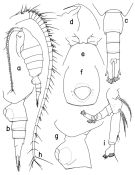 issued from : T. Park in Bull. Scripps institution Univ. California, San Diego, 2000, 31. [p.195, Fig.43]. Female: a, habitus (left side); b, urosome (left side); c, idem (dorsal); d, forehead (left side); e, idem (dorsal); f, genital somite (ventral); g, idem (left side); h, left A1; i, left A2 (posterior).
|
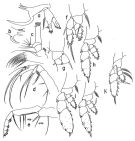 issued from : T. Park in Bull. Scripps institution Univ. California, San Diego, 2000, 31. [p.196, Fig.44]. Female: a, left Md (posterior); b, masticatory edge of right Md (posterior); c, left Mx1 (posterior); d, left Mx2 (posterior); e, right Mxp (anterior; asp: anterior spine; psp: posterior spine); f, first leg (anterior); g, idem with distal segments of rami omitted (posterior); h, second leg (anterior); i, third leg (anterior); j, fourth leg (anterior); k, fifth leg (anterior)
|
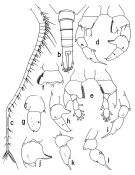 issued from : T. Park in Bull. Scripps institution Univ. California, San Diego, 2000, 31. [p.197, Fig.45]. Male: b, urosome (dorsal view); c, A1; d, leg5 with endopods omitted (posterior); e, leg5 with distal exopodal segments omitted (anterior); f, basipod of right 5th leg; g, two distal exopodal segments of right 5th leg (posterior); h, exopod of right 5th leg (anterior); i, exopod of left 5th leg (anterior); j, second exopodal segment of right 5th leg (anterior); k, exopod of 5th leg (anterior); l, idem (posterior)
|
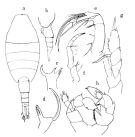 issued from : O. Tanaka in Publs Seto Mar. Biol. Lab., 1964, XII (1). [p.19, Fig.182]. As Heterorhabdus robustus. Female: a, habitus (dorsal); b, last thoracic segment and urosome (left lateral side); c, d, biting part of Md; e, Mx2; f, Mxp; g, P5. Nota: The urosome segments and furca are in the proportional lengths as 34:15:13:12:26 = 100; thre is a row of small denticles on the periphery of the genital opening (lateral view). Male: h, P5. Nota: The urosome segments and furca are in the proportional lengths as 19:15:15:17:8:28 (left) = 100. Right A1 reaches back to the end of the anal segment. left A1 modified into a grasping organ.
|
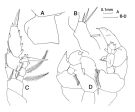 issued from : J.M. Bradford-Grieve in The Marine Fauna of New Zealand: Pelagic Calanoid Copepoda. National Institute of Water and Atmospheric Research (NIWA). NIWA Biodiversity Memoir, 111, 1999. [p.86, Fig.53]. As Heterorhabdus (Paraheterorhabdus) robustus. Female: A, genital somite (left lateral side); B, Mxp (basipod 1); C, P5. Male: D, P5.
|
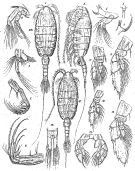 Issued from : G.O. Sars in Résult. Camp. Scient. Prince Albert I, 69, pls.1-127 (1924). [Pl.LXI, figs.1-16]. As Heterorhabdus robustus. Female: 1, habitus (dorsal); 2, idem (lateral left side); 3, rostrum; 4, A2; 5, Md; 6, left Md (biting edge); 7, Mx1; 8, Mx2; 9, Mxp; 10, P1; 11, P2; 12, P3; 13, P5; 14, anal segment and caudal rami (dorsal). Male: 15, habitus (dorsal); 16, P5.
|
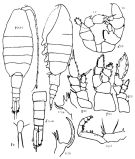 Issued from : K.A. Brodskii in Calanoida of the Far Eastern Seas and Polar Basin of the USSR. Opred. Fauna SSSR, 1950, 35 (Israel Program for Scientific Translations, Jerusalem, 1967) [p.347, Fig.243]. As Heterorhabdus robustoides. Female (from NW Pacific): habitus (dorsal and lateral left side); R, rostrum; M Ri, Md (biting edge, right side view); M Le, Md (biting edge, left side view); Mp2, Mxp; S1, P1; S3, P3; S5, P6. Male: S5, P5 (Le = left leg; Ri = right leg).
|
 issued from : M.V. Heptner in Trudy. Inst. Okeanol., 1971, 92. [p.157, Fig.39]. As Heterorhabdus robustus. Female & Male (from Kuril-Kamchatka Trench).
|
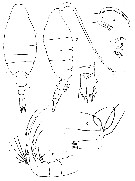 issued from : G.P. Farran in Fish. Ire. Sci. Invest., 1906, II [1908]. [Pl. VII, Figs.1-10]. As Heterorhabdus robustus. Female (from W Ireland): 1-2, habitus (dorsal and lateral, respectively); 3, anal segment and caudal rami (dorsal); 4, left Md (biting edge); 5, right Md (biting edge); 6, Mx2; 7, Mx1 ( exopod and endopod); 9, P5; 10, P2.
|
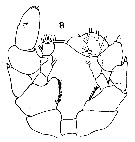 issued from : G.P. Farran in Fish. Ire. Sci. Invest., 1906, II [1908]. [Pl. VII, Fig.8]. As Heterorhabdus robustus. Male: 8, P5.
|
 Paraheterorhabdus (Paraheterorhabdus) robustus Paraheterorhabdus (Paraheterorhabdus) robustus female: 1 - Left caudal ramus distinctly longer than right and completely fused with anal segment (Fig.43-c) 2 - Dorsally, posterolateral corners of prosome angular (Fig.43-c). 3 - Laterally, 2nd urosomal somite (Fig.43-b) without a swelling along ventral margin. 4 - Laterally, posterior slope of genital prominence straight (Fig.43-g). 5 - Genital somite about as long as wide (Fig.43-c). 6 - Ventrally, genital operculum (Fig.43-f) wider than long.
|
 Paraheterorhabdus (Paraheterorhabdus) robustus Paraheterorhabdus (Paraheterorhabdus) robustus female: 1 - Left caudal ramus distinctly longer than right and completely fused with anal segment (Fig.45-b). 2 - Basis of right P5 with conical inner lobe (Fig.45-e). 3 - P5 with relatively slender exopods (Fig.45-d); medial projection of 2nd exopodal segment of right P5 without a lobe on distal side. 4 - Medial projection of 2nd exopodal segment of right P5 toothlike (Fig.45-j). 5 - In 3rd exopodal segment of left P5(Fig.45-d), inner spine much higher in position than outer spine.
| | | | | Ref. compl.: | | | Galbraith, 2009 (pers. comm.); Park & Ferrari, 2009 (p.143, fig.1, biogeography); Zaafa & al., 2014 (p.67, Table I: as Fleterarhabdus mbustus lapsus calami , occurrence): Chiba S. & al., 2015 (p.968, Table 1: length vs climate); El Arraj & al., 2017 (p.272, table 2, spatial distribution); | | | | NZ: | 14 | | |
|
Carte de distribution de Paraheterorhabdus (Paraheterorhabdus) robustus par zones géographiques
|
| | | | | | | Loc: | | | Atlant. (South tropical), G. of Guinea, off Lagos, off Mauritania, Canary Islands, Azores, off Ireland ( S & W), off Cap Finisterre, Bay of Biscay, S Davis Strait, Iceland, Faroe Is., G. of Mexico, off Bermuda (Station "S"), Sargasso Sea, off E Cape Cod, ? off Newfoundland E, Ibero-moroccan Bay, off W Tangier, Mozambique Channel, SW Indian, Malay Archipelago, Philippines, Japan (Sagami), Nansei Is., Kuril-Kamchatka, Bering Sea, Pacif. (central, subarctic), S Aleutian Is., ? G. of Alaska (Icy Strait), off British Columbia, S California, off Colombia, Chile N & S (sub-Antarctic), New Zealand (SW North Island), Tasman Sea, ? Antarctic (in Farran, 1929) | | | | N: | 41 | | | | Lg.: | | | (1) F: 3,7; (16) F: 3,7-3,05; (22) F: 5-4,8; M: 4,8-4,6; (23) F: 4,9-5,3; M: 4,75-5,25; (24) F: 4-3,5; M: 3,7-3,4; (38) F: 3,6-3,48; M: 3,36; ? (121) F: 4,75-3,83; M: 4,9-3,45; (199) F: 3,57-3,34; M: 3,5-3,12; (208) F: 5; M: 5,3-4,4; (808) F: 3,4-3,16; (824) F: 4,16-2,92; M: 3,96-2,92; (909) F: 3,2-3,4; M: 3,2; (1108) F: 2,96-3,57; {F: 2,92-5,30; M: 2,92-5,30}
Chiba S. & al., 2015 (p.971, Table 1: Total length female (June-July) = 4.1 mm [optimal SST (°C) = 7.4]. | | | | Rem.: | méso-bathypélagique.
Certaines localisations sont douteuses faute de connaître les documents faunistiques utilisés par les auteurs, notamment dans le Pacifique nord.
Sa présence dans le sub-Antarctique nécessite confirmation.
Voir aussi les remarques en anglais | | | Dernière mise à jour : 28/10/2022 | |
|
|
 Toute utilisation de ce site pour une publication sera mentionnée avec la référence suivante : Toute utilisation de ce site pour une publication sera mentionnée avec la référence suivante :
Razouls C., Desreumaux N., Kouwenberg J. et de Bovée F., 2005-2025. - Biodiversité des Copépodes planctoniques marins (morphologie, répartition géographique et données biologiques). Sorbonne Université, CNRS. Disponible sur http://copepodes.obs-banyuls.fr [Accédé le 05 janvier 2026] © copyright 2005-2025 Sorbonne Université, CNRS
|
|
 |
 |













